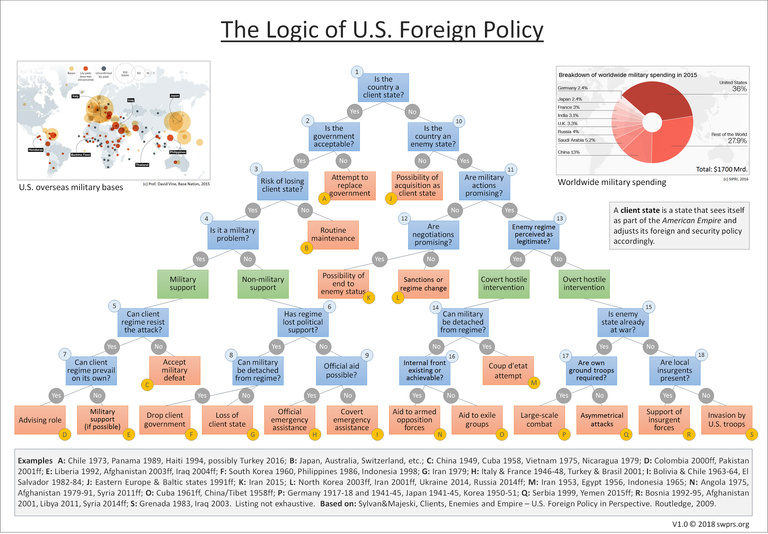The USA is the world record holder in toppling democratically elected governments, and likely also in installing dictators instead. The best known examples are Iran 1953, Guatemala 1954 and Chile, especially under Allende.

But why did the US do that?
The first two examples I have listed fell into the time of the “Red Scare”, when the US feared it might be surrounded by communist states if they don’t interfere in the natural proceedings, and Chile under Allende was feared to install a socialist state.
But that is not the explanation, or more precise it is only a temporary part of it. The “communist danger” is just the excuse of the time.
History
All Empires in all times have always sought to grow in power and get bigger. That is not necessarily because all Emperors are bloodthirsty. It is instead part of the inherent logic of Empires to grow.
Because the bigger your empire, the more soldiers you have and the safer you are from other states or empires. Also the length of borders you have to protect are getting smaller compared to the size of the enclosed land (and population) if you grow.

A circle with the radius of 1 has the double the circumference (6.28) of it’s surface area (3.14). But a circle with the radius 10 has only 1/5 the circumference (62.8) of it’s surface area (314)
Add to this that victories with vast amounts of plunder and slaves make your own people happier and richer, and it is easy to see why even peaceful emperors might be pressed to go to war.
The modern USA
Of course the USA are (no longer) busy with increasing their country on the cost of their neighbors.
In the modern world a certain part of direct wars have changed to wars on the political and economic scale, not least because the potential costs of war inside the country have increased while the importance of plunder has plummeted.
But one important point has not changed: If you are not my friend, you are my enemy.
Using this reasoning, the Romans and others created Client States when acquisition was not feasible.
In the post-WWII world that meant either the Warsaw Pact members or NATO members, militarily speaking. But in the economic or political field the borders were less clear cut.
The mere existence of a state with adversarial opinions, even if totally peaceful, and especially if it is close to the Empire, is an affront that cannot be tolerated.
That is the reason why the NATO East Enlargement (the fifth with most important the Baltic states) was a sort of self-fulfilling prophecy of an imperialistic Russia, as it is now active on the Crimea or Syria. The NATO broke their promise and placed it’s members right at Russia’s borders.

pic from Socio-Economics History Blog
On the American continents the mere presence of a socialist state was such a thread, and the USA acted accordingly ruthlessly. In the Middle East, it was the control of the flow of oil that was the important point. Sometimes the interventions were merely monetary, sometimes directly military with lame excuses (Weapons of Mass Destruction).
The decisions to make covert actions, invade or simply impose economic restrictions are made almost purely out of politic-economics. What is the cheapest way to achieve the goal?
It is actually quite easy, at least in the aftermath, to follow the path of decision.
Let’s have a look at a famously failed attempt of the US to oust a thread on it’s borders: Cuba.
At first the US was favorable towards Castro and his revolution. But when he legalized the communist party and took land owned by US citizen’s away in an agrarian reform, the stance changed.
The first step were increasing economic sanctions (which are a topic even today).
When in turn Castro signed a trade agreement with the Soviets in 1960, US president Eisenhower told to CIA to create a coup. One year later US Bombers attacked Cuba to help The Bay of Pigs Invasion, which still failed spectacularly.
Looking at the chart (Likely too small on Steemit, direct link) you can easily see the questions and decisions.
Is the country a Client State? no
It is an enemy? yes
Are military actions promising? no (1959, Agrarian Reform)
Negotiations promising? No
→ Sanctions (enacted) or Regime Change (CIA: build a force)
And when the force was perceived to be strong enough, we have this path:
Are military actions promising? yes
Enemy regime legitimate (note: the most ambiguous point, it can also just mean: Too costly to do anything): Yes
→ covert hostile intervention
Can military be detached from regime? no
Internal front existing or achievable? No
→ Aid to exile groups (the exiles that would later land in the Pig Bay)
As you can see it is really quite simple and nearly every imperialistic action can be explained with this “guideline”. Take Russia’s grab to take the Crimea back: You can go down the right side until the last point, where a mix of insurgent support and direct invasion (undercover) happened.
And if you take e.g. Afghanistan and the countries around you are (today) on the left branch.
I hope you now have a better understanding of global politics and the reasoning for actions.


Upvoted.